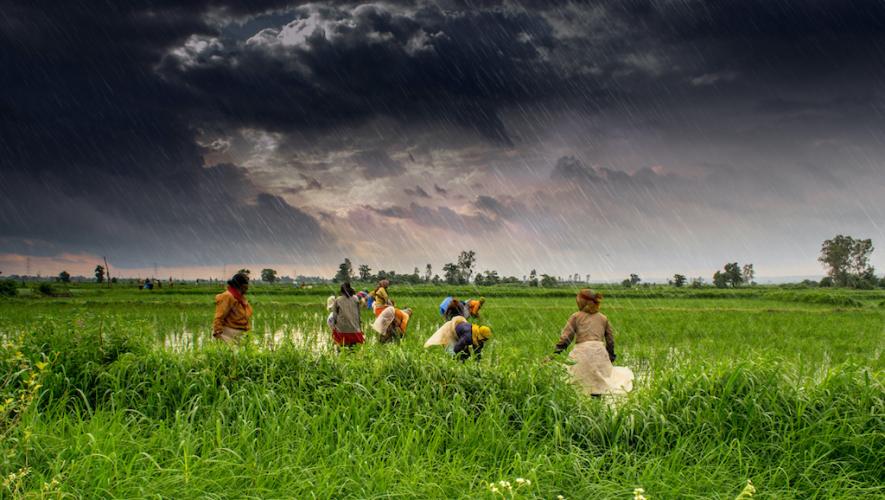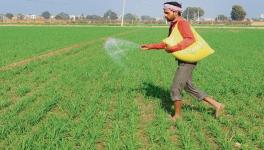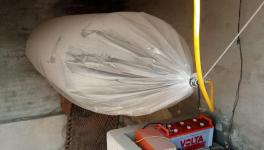Russia Ukraine War Posing Challenges in Fertiliser Supply of India

A direct economic impact of the Russia-Ukraine war is that food, energy, and fertiliser prices will rise unless the animosities end soon. This is primarily because Ukraine is a major food grain – wheat and corn – producer. Russia is a major natural gas supplier to Europe, and the Black Sea area is a significant hub of fertiliser production and trade. Besides, it has also brought the severity of sanctions imposed by superpowers on their opponents to the public domain.
Several experts shared their views with NewsClick on the current crisis. MP Sukumaran Nair, former chairman of Public Sector Restructuring & Audit Board, Government of Kerala, said, "The aggression between Russia and Ukraine will impact India's fertiliser supplies in a big way regarding price and availability. Around 2.4 million tonnes of ammonia in India is shipped from Pivdenny port (Odessa) in 2021. Only 0.15 million comes from Ukraine and the rest from Russia is supplied through Togliatti Azot and Rossosh pipelines."
Nair, who is also the former head of Fertilisers and Chemicals Travancore, explained that Russia is the second-largest producer of ammonia, urea, potash and the fifth-largest producer of complex phosphates. The country accounts for 23% of the global ammonia export market, 14% urea, 21% potash, and 10% complex phosphates. The war has already started disrupting the global fertiliser market, as Russia is a leading supplier of fertiliser and related raw materials. It is also the largest exporter of urea, nitrogen-phosphorous and potassium, ammonia, urea ammonium nitrate (UAN) and ammonium nitrate (AN), and the third-largest potash exporter.
In the phosphatic sector, traditionally dominated by China and Morocco, Russia is a major exporter with 4 million tonnes of diammonium phosphate and mono ammonium phosphate (DAP/MAP) shipments last year. Together with Belarus, it controls 40% of the world's potash trade. He said that the Black seaports of Yuzhny and Odessa are major fertiliser handling ports with pipeline transport facilities for ammonia from Russia.
INDIA’S OVERDEPENDENCE ON FERTILISER IMPORTS
"India depends heavily on imports for meeting its fertiliser raw materials (natural gas, sulphur, and rock phosphate), intermediates (ammonia and sulphuric and phosphoric acids), and finished products (diammonium phosphate, potash, and complex fertilisers) requirements. The self-sufficiency in urea production achieved by 2000 was lost due to unfriendly policies that discouraged further investments in the sector for two decades and the privatisation move and closure of several plants on account of low energy efficiency, which paved the way for large scale exports," Nair said.
He further elaborated on the issue, saying that India, the world’s largest urea importer, also significantly imports phosphatic and potassic fertilisers. Urea imports amount to 8-9 million tonnes per annum, mainly from China, Oman, Ukraine, and Egypt. China has restricted urea imports since October 2021. As gas prices go up, imported ammonia price also follows suit. A significant part (5 million tonnes per year) of the urea supply shortage could be met by maximising production in the newly revamped and ready to commission fertiliser plants at Gorakhpur, Barauni, Sindri and Talcher.
EAS Sarma, former secretary of Economics Affairs, said that three units in India having a total capacity of 2.3 million tonnes of phosphatic products had been planned, but they will become productive only by the end of 2023.
Concerning potash supplies, he said, "Around 4 million tonnes a year of potash are fully imported from Canada, Russia, Belarus, Jordan, Lithuania, Israel, and Germany. Current imports, of course, are going to be at much higher rates because of the emergent situation in these countries. Earlier, our major suppliers of DAP are Saudi Arabia, Morocco, and China."
He said that China had already restricted exports of DAP last year, so India is already constrained to tap Morocco, Saudi Arabia and Jordan in the wake of the war between Russia and Ukraine. Budget allocation for fertiliser subsidy in the 2022 budget is only Rs 1.05 lakh crores which are lower than that for the previous year by Rs 35,000 crores. This estimate is likely to go haywire on account of the war.
ADVERSE IMPACT OF SUPPLY CHAIN DISRUPTION
Disruption in production in Russia and Ukraine and closure of plants in Europe will increase fertiliser commodity prices all across the world. A shift in product movement from traditional markets will lead to price volatility in the global fertiliser market, significantly impacting availability. "Had we continued the fertiliser expansion policy of the 1980s and 1990s, where fertiliser PSUs contributed significantly to meet our demand for mineral-based plant nutrients, we would not have been in such a precarious situation as we are now. Today, Indian farmers are hard-pressed for the easy availability of fertiliser products, whose prices have also skyrocketed. Only urea, which remains under administrative price control, is cheap and affordable to farmers," said Sarma.
Experts believe that the immediate need of the hour is that the Government of India rushes to tie up alternate supplies and ensure adequate availability of mineral nutrients to the farmers. Any laxity in doing so will adversely affect the nation's food security in a couple of years. Besides, we may have to fast-track the commencement of production in the plants already under implementation.
“A significant part (5 million tonnes per year) of the urea supply shortage could be met by maximising production in the newly revamped and ready to commission fertiliser plants at Gorakhpur, Barauni, Sindri and Talcher.” Thomas Franco, coordinator at the People’s Commission on Public Sector and Public Services, recommended, “Three units having a total capacity of 2.3 million tonnes of phosphatic products are planned, but they will become productive only by the end of 2023. Based on a quick review, a plan of action should be adopted to advance the commissioning of some of these units to provide immediate relief.”
He said that the government needs to quickly make alternate import arrangements for Potash supplies and make appropriate budgetary provisions to absorb the import price increases. “The immediate need of the hour is that the government of India should rush to tie up alternate supplies and ensure adequate availability of mineral nutrients to the farmers. Any laxity in doing so will adversely impact the nation's food security in a couple of years.
He said that the Government of India must rush to tie up alternate supplies and ensure adequate availability of mineral nutrients to the farmers. Any laxity in doing so will adversely affect the nation's food security in a couple of years. Besides, we may have to fast-track the commencement of production in the plants already under implementation.
IMPORTANT LESSONS TO BE LEARNT
There are important lessons that the Government should draw from the uncertainties that have arisen on account of the Ukraine war. Fertilisers, electricity, diesel, and water are critical inputs for maintaining the nation's food security.
According to Franco, excessive dependence on fertiliser imports, as is the case now, has created a severe uncertainty in fertiliser availability and volatility in fertiliser prices, a situation that would have been mitigated to a large extent, had India pursued the fertiliser expansion policy of the 1980s and 1990s, where fertiliser PSUs contributed significantly to meet our demand for mineral-based plant nutrients. Considering that the agrarian economy has come under severe stress and the farmer's plight has worsened, policies in respect of all critical inputs for agriculture, namely, electricity, water, diesel and fertilisers, need to be revisited.
He said, "In the specific case of fertilisers, only urea which still remains under administrative price control is cheap and affordable to farmers. The government should also bring the other fertilisers under the administrative price control regime. In addition, there is a strong case for the government to strengthen and expand the role of the CPSEs (Categorisation of Public Sector Enterprises) in the fertiliser sector. Given this, the present proposal of DIPAM (Department of Investment and Public Asset Management) to privatise some CPSEs such as Madras Fertilisers and National Fertilisers should be shelved forthwith."
The writer is a freelance journalist.
Get the latest reports & analysis with people's perspective on Protests, movements & deep analytical videos, discussions of the current affairs in your Telegram app. Subscribe to NewsClick's Telegram channel & get Real-Time updates on stories, as they get published on our website.























